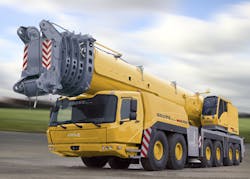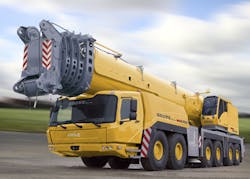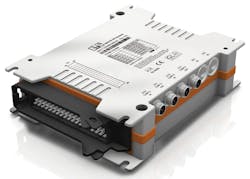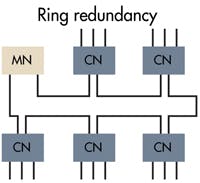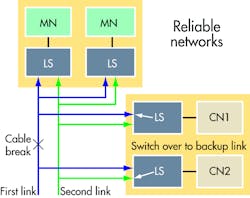Real-time Ethernet for Mobile-Equipment Controls
This file type includes high-resolution graphics and schematics when applicable.
Construction, mining, and agricultural machines have become amazing platforms of mobile automation. GPS, for instance, is quickly becoming ubiquitous for everything from grade control on dozers and variable-rate seeding in precision farming, to fleet-management operations and starter-disabling and geo-fencing features that substantially lower the risks of equipment theft and misuse.
Joystick controls and touchscreen displays work with load-sensing hydraulics and “smart” cylinders to enhance precision, efficiency, and ease of use. Such subsystems communicate with advanced engine controls that match power to demand, minimizing fuel consumption while meeting stringent Tier 4 emission requirements.
Safety also continues to improve, thanks to the increasing use of cameras on large equipment and stability controls that prevent rollovers on rough or uneven terrain. And service technicians now use remote diagnostic links to quickly troubleshoot issues without needing to travel to the machine.
All this is just the beginning. Soon, condition-monitoring sensors and software on machines will send e-mails or texts when components show the first signs of failure. “Connected” machinery will help prevent collisions between pieces of equipment on site. Robotic-type automation will also be more prevalent as OEMs cater to remote control of demolition and mining equipment working in restricted or hazardous environments. And though just in its infancy, autonomous machines packed with vision and positioning sensors, and artificial intelligence, will need no human operator at all.
All these advances continue to improve safety, efficiency, productivity, and return on investment. But they’re also taxing the limits of onboard control networks, particularly as they relate to bandwidth and real-time determinism. While CAN networks have become increasingly common in mobile equipment over the last 10 to 15 years, there is now a growing interest in alternative control networks which offer much better performance.
CAN out, Ethernet in
As off-highway machines becomes more automated and connected, CAN-based networks are showing their age. The advances noted above mean construction, ag, and other types of mobile equipment increasingly require greater bandwidth, determinism, and data-handling sophistication than in the past, and these requirements will continue to grow — most likely exponentially.
As a result, OEMs are looking to Ethernet, the network standard for business, home, industrial, and now automotive applications. The solution appears obvious until one asks, which Ethernet? There are many variations and, depending on the application, each has its advantages and disadvantages.
Hoping to maximize economies of scale, many mobile-equipment builders are considering the Ethernet variants taking hold in the auto industry. After all, this is where CAN came from. But the mobile-equipment world is more demanding than the automotive, so engineers are advised to investigate Ethernet as it has evolved in a more relevant market: deterministic industrial control.
Although Ethernet TCP/IP is the preeminent network of the workplace, it lacks the determinism needed for manufacturing processes and, increasingly, for mobile-equipment tasks. Data packets crash and get resent with delays that go unnoticed waiting for a page to print. But in applications where many nodes must be tightly synchronized for high precision and speed with absolute reliability, this is unacceptable.
Cost is becoming a nonissue, too. Modern semiconductor manufacturing has largely rendered economies of scale irrelevant in terms of chip cost-versus-performance trade-offs. Field-programmable gate arrays (FPGAs) have made purpose-built chips price competitive, so it’s no longer necessary to compromise performance to leverage the cost of high-volume, application-specific integrated circuits (ASICs). In capital equipment, these performance advantages quickly outweigh the few dollars saved.
One industrial Ethernet standard that has emerged, Powerlink, warrants the attention of mobile-equipment designers because it is extremely robust yet truly open source, meaning license and patent-free. It includes an open-source safety protocol, conforms to IEEE 802.3 and IEC 61784-2, and is supported by thousands of industrial device and machinery makers worldwide.
A look at Powerlink
Powerlink is efficient and effective at handling the large data requirements of modern off-road vehicles. This real-time Ethernet standard addresses both data and control on a single wire, while reducing design costs and minimizing jitter to maximize system performance. And it uses standard Category 5 or 7 Ethernet cables and connectors, which some other versions of Ethernet do not.
Powerlink provides reliable and deterministic real-time communications for automation. It solves the determinism problem with a simple collision-avoidance scheme. The protocol uses standard Ethernet frames (data packets) and has a bus master called the Managing Node (MN); all other network components are Control Nodes (CN).
Powerlink is a cyclical protocol with bus cycle time determined during configuration. The cycle is split into two phases. During the first (isochronous phase) the MN and CNs transmit time-critical information in a scheduled manner, avoiding frame collisions. In the second part of the cycle (asynchronous phase) all nodes transmit nontime-critical data as needed using standard Ethernet protocols such as TCP/IP or SNMP.
The MN initiates the cycle by placing a start-of-cycle (SoC) frame on the bus. This tells each node to get ready to transmit its frame. To start data communications for each cycle, the MN sends a Poll Request Frame (PReq) to every CN on the network. Each CN then responds by immediately placing its data in an Ethernet multicast frame (PRes), making the data available to all nodes on the network. This permits real-time deterministic cross communication and synchronization between all network nodes.
Automation networks typically contain a variety of components such as drives and encoders that require high-frequency data updates, and sensors that require lower-frequency updates. To make the network efficient, Powerlink transmits high-frequency data over the bus every cycle, while low-frequency data is multiplexed and only placed on the bus every nth cycle. (Data-transmission details are set at start-up.) Bus multiplexing lets all devices operate on the network without degrading the performance of any component or the network itself.
Another route to network efficiency is Poll Request Chaining. In this mode, the MN issues one poll request to all nodes, which prompts each node to place its data on the network after a unique set delay (which is configured for each node during start-up). This is ideal for networks with many nodes running at high frequencies.
CANopen over Ethernet
Another benefit is that Powerlink uses similar device-description files as CANopen, as well as the same software interface, Object Dictionaries, and communication mechanisms such as Process Data Objects (PDO), Service Data Objects (SDO), and Network Management (NMT). As with CANopen, direct cross-traffic is also one of Powerlink’s essential features.
As applications get more complex, it leads to more nodes, rising data loads, and higher performance requirements. A simple migration to Powerlink is a good alternative for users who wish to continue to enjoy CANopen’s benefits in spite of more-demanding requirements.
CAN networks tend to operate at a maximum baud rate of 1 Mbit/sec, and CAN frames have a typical payload of a few bytes. Powerlink tends to operate at 100 Mbits/sec with an Ethernet frame of 1.5 Kbytes, thus allowing for a much higher data bandwidth. While CAN networks generally operate at minimum 2 to 3-msec cycle-times, Powerlink typically runs at 250 to 400-μsec cycle times for medium-size systems. Small systems can have considerably shorter cycle times.
Alternative real-time Ethernet
Switched Ethernet. To address nondeterminism and data crashes, TCP/IP-based networks like Profibus and Ethernet IP have adopted switched Ethernet. These networks use a switch to connect and create a virtual link between two components on the network. That link effectively lets the components communicate without collisions.
However, collisions are still possible if the connected components perform other tasks, such as sending and receiving messages to and from other devices — though the switch does its best to mitigate that traffic.
In automation systems, so-called managed switches have been adopted. These require a considerable amount of configuration for every switch, to minimize collisions. And managed switches can be quite expensive. Switched networks also result in queues. If a networked component tries to communicate with a device that is busy, the data packets are queued. The length of the queue depends on the switch, the network, traffic, and so on. Queues are, in general, not a good idea in real-time applications because queues can vary in length and that, in turn, means a variation in response time. And should the queue get too long, packets get dropped and must be retransmitted.
Token-ring Ethernet. Other real-time Ethernet protocols, such as Sercos III and EtherCAT, provide fast and low-latency communications based on a token-ring concept. They use a sum frame whereby individual frames move from node to node. Each node adds its own data to the frame and passes it onto the next node on the ring. Although this works well on systems with a small number of nodes, it has some limitations.
If network topology is anything other than a ring, such as a star or tree, communications become less efficient. A frame starts at the central node, gets passed to each leaf node, and then back to the central node. This process repeats for each leaf node, so the network gets slower with each new node. With Powerlink, adding more nodes introduces minimal delays.
With the sum-frame concept, node-to-node communications and synchronization slow down as the number of nodes increases. Every device only reads data sent to it by the master. So if information must be sent from one node to the next, first it must go to the master, and then on to the intended node. In a worst-case scenario, data travels around the ring twice to reach its intended location. Powerlink uses multicast frames, so data published by a node is immediately available to all nodes. The number of nodes does not affect communication between nodes.
Token-ring networks are also more susceptible to electromagnetic interference (EMI). Because a frame collects more and more data as it travels around the network, if it’s corrupted due to an EMI spike, all the data for all the components are lost for that cycle. The problem gets worse as the number of nodes increases. Because a Powerlink frame contains data from only one node, the effect of EMI corruption is significantly lower in noisy environments such as slip rings.
Finally, because the Powerlink cycle is split into isochronous and asynchronous phases, it lets networked components transmit status updates, video frames, and other low-priority data without impeding network performance.
Reliability
It is typically quite costly when automation networks go down, so protocols must build in high uptime and availability. Powerlink provides this in three ways. The simplest is ring redundancy. Each CN has two Ethernet ports connected internally by a hub. To form a ring, the CNs are daisy-chained and the last CN connects back to the MN. In this configuration, the network continues to operate even if any single cable breaks or accidentally disconnects.
Full-medium redundancy is another method to ensure high availability. This setup has two physical cables and networks connected to each node via a link selector. The link selector detects when the network on one cable is down and automatically switches over to the other.
A third form of high availability is master-node redundancy. The MN is responsible for network timing and synchronization, so an MN failure brings the entire network to a halt. To avoid this, Powerlink allows up to nine additional redundant masters, and control automatically gets passed to an available MN should the main MN go down. This switchover takes place within one bus cycle and causes minimal interruption to the network.
Performance and diagnostics
Powerlink’s guaranteed collision-free behavior lets it deliver high performance even in large, heavily used automation networks. For example, it is possible to run a system with 800 digital I/O points, 180 analog I/Os, and 24 axes of motion at a 250-μsec cycle time.
Powerlink uses standard Ethernet frames with Ethertype 0x88AB. This is significant because it means standard hardware and network-analysis software can be used. For instance, with recommended hub technology, it’s easy to debug faults using standard tools such as Wireshark and Omnipeak.
Connecting standard Ethernet devices to Powerlink networks is simple, but they must connect through gateways. The gateway essentially passes frames to and from devices during the cycle’s asynchronous phase — ensuring devices do not speak out of turn during the time-critical isochronous phase. This makes it easy for technicians to plug a laptop into the network for maintenance and diagnosis.
The protocol complies with IEEE 802.3 and IEC 61784-2, so Powerlink devices are hot-pluggable. Any component may be replaced without shutting down the network, reducing service and maintenance costs.
Users can download Powerlink source code at Sourceforge.net. The network interface can run on a microprocessor as a software-only solution. However, microprocessors running a standard RTOS may suffer from jitter, thus reducing efficiency. For jitter-free performance, Powerlink network interfaces may use an FPGA (FPGA code is also open source) or any of the many off-the-shelf ASICs developed by manufacturers such as Hilscher, HMS, Intel, ST Electronics, and Texas Instruments.
Finally, standard Ethernet has high immunity to electromagnetic inductance, making Powerlink well suited for remote I/O in environments with a high level of electrostatic noise.
Powerlink lets system designers build completely integrated architectures with all remote I/O connected to one network. And thanks to being an open standard, it gives OEMs and machine builders access to a wide range of devices such as sensors, motors, actuators, and vision systems when developing high-performance networks without being limited to a single component provider.
